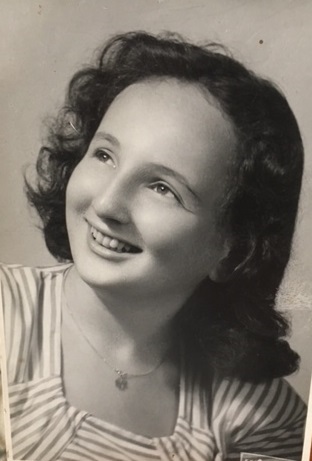
Susan Darvas was born Susan Lakatos on April 24, 1934 in Budapest, Hungary to an assimilated Jewish family. Her father, Mano, owned a pioneering dental laboratory in Budapest employing both Jews and gentiles. Susan’s mother, Margit, assisted Mano in his dental practice. Susan was very close to her two cousins, Magdi and Imre, and they were constant playmates.
In September 1939, Nazi Germany invaded Poland, beginning World War II. Susan’s uncle, Laszlo, decided to immigrate to England to protect his children, Magdi and Imre. Laszlo tried to convince Mano and his two other brothers to join him, but was unsuccessful, as they were convinced that Hungary would be safe from Nazi invasion. The English-Hungarian school Susan attended was closed, so she attended kindergarten and first grade in public school where she was regularly harassed because she was Jewish. It was not long before Jewish children were no longer allowed to go to school, and it became unsafe for Jewish children to play outside.
By early 1944, many Jews in Budapest were ordered to evacuate their homes and relocate to designated Jewish houses. Susan and her family were forced to leave behind most of their belongings and move to a crowded apartment with her uncle, aunt, and other families. They were ordered to wear large yellow stars on their outer garments and were allowed to leave the house for only a few hours a day at designated times. As there was already a food shortage and rationing due to the War, the restricted times made it difficult to get food.
One day, a young German officer knocked on the door of the apartment. He was the boyfriend of one of Mano’s former employees. The young officer treated the family with kindness and brought them food at times. Noticing that nine year old Susan was unhappy confined inside the crowded apartment, he took her to a local swimming pool. Her family believed she would be safe with him. However, someone at the pool recognized her and contacted the local authorities. She narrowly escaped arrest and deportation.
A few weeks later, members of the Arrow Cross Party, Hungarian fascists, rounded up all of the Jews in the house where Susan lived. They, along with many others, were marched through the streets and ordered to hold their arms above their heads. They were subjected to jeers and abuse from bystanders. Eventually, they were herded into the synagogue without food, water, or access to toilets under increasingly crowded conditions. After a couple of days, they were released and sent back home.
In late 1944, through his connections with gentiles, Mano was able to secure an affidavit, which allowed the family to move out of the Jewish house and into a building ostensibly under the protection of the Spanish government in another part of the city. Conditions in the building were terrible. There were eight families crowded into one apartment. Susan slept under the piano to avoid being stepped on. Food and water were scarce. Susan and others ventured out into the streets, risking arrest or death, to find food and drinking water. Air raids and artillery attacks intensified and the unheated cellar served as the only available air raid shelter, although it could accommodate only some of the occupants.
By early 1945, attacks from Allied forces were becoming more frequent. While watching the bombs fall from the second story window of their apartment, Susan, along with her father and grandfather, heard cheers coming from neighboring buildings. At that moment, a grenade exploded near their apartment, permanently injuring Mano.
After liberation, the family returned home and began to rebuild their lives. In 1949, the communist regime began in Hungary reintroducing restrictions and persecution. Susan escaped Hungary through the mountains with her husband. After a stay in a refugee camp and two years in England, they eventually immigrated to the United States. She volunteered at the United States Holocaust Memorial Museum.
